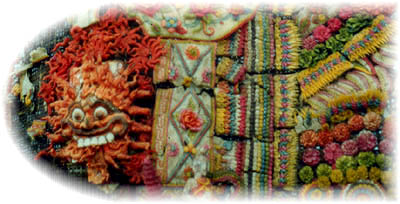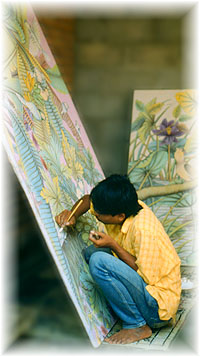
The cool, quiet air of the morning brushes gently by. Low sunlight dances among the foliage. Our footfall makes little sound as we run down a packed dirt pathway, through the rural Balinese landscape around us. Ducks flock across our path, barely noticing us pass, engrossed as they are in their social chatter. Guiding the flock onward, two children smile in greeting. The day is gently waking...
A Day in Rural Bali
We turn onto a untrafficed lane. On the roadside, three women are walking, talking, their banter quickening as we approach. One briefly jogs with us, her sarong swirling lightly in the breeze about her. They find us amusing, we jogging tourists, and a jogging woman especially so. We share their laughter in the calm of the morning.
If asked, we say these morning runs are to keep us in shape. But really they are a microcosm of our travels at large. These easy runs take us down the country paths and byways not normally a part of day-to-day tourism. We find there not so much sights to be seen, the mainstay of any tourist agenda, but slices of life to be savored.
 Traditional Balinese families don't live in single-building homes. They typically have several structures spread across the family's plot of land: one building with rooms for cooking and eating, another with sleeping quarters, and yet other separate structures for the grandparents, for work rooms, for animal quarters, ... Our lodging is within such a family compound - called a losman, it's the Balinese equivalent of the European B&B in a private home. We cool off outside the front gate for a few minutes. Inside its walls, a dozen small buildings are spread around the grounds, with plants and flowers, a riot of tropical colors, lining the paths among them all.
Traditional Balinese families don't live in single-building homes. They typically have several structures spread across the family's plot of land: one building with rooms for cooking and eating, another with sleeping quarters, and yet other separate structures for the grandparents, for work rooms, for animal quarters, ... Our lodging is within such a family compound - called a losman, it's the Balinese equivalent of the European B&B in a private home. We cool off outside the front gate for a few minutes. Inside its walls, a dozen small buildings are spread around the grounds, with plants and flowers, a riot of tropical colors, lining the paths among them all.
For around US$5 per night, we have a small bamboo-frame structure in the back by the rice padis. There are two rooms inside, the sleeping room and the mandi, or bathroom and W.C. The mandi is quite functional, with a tiled basin filled with water, for all your cleaning needs. The bed in the front room is firm, with crisp white sheets and an airy mosquito-netting draped around it. On a lazy afternoon, I will lay there entranced, staring off into the geometries of the bamboo rafters. The roof is made of thousands of bamboo strips, sliced lengthwise and bound together to channel away the rain. It must be at least one-foot thick all around. Inside here, the rain sneaks up very quietly. When tropical thunderstorms pass through, we never hear the traditional pounding of large drops on the rooftop, for the thick layer insulating the sound.
 After cooling down after our run, we head back to the mandi and wash up. Breakfast arrives on our front porch; today it's fruit, pancakes, and tea. The teenager who brings it has some extra time, so he stays to chat while we eat. His English is quite good, and he shares with us of his goal of attending a university, putting those costs into their local context. His name, Ktut, means "Fourth" - he was the fourth child in his family. The Balinese tradition is to name one's children by their birth order: Wayang, the first born; Made', the second; Nyoman, the third child; and finally, Ktut. As the third of four siblings, I'm re-christened Nyoman.
After cooling down after our run, we head back to the mandi and wash up. Breakfast arrives on our front porch; today it's fruit, pancakes, and tea. The teenager who brings it has some extra time, so he stays to chat while we eat. His English is quite good, and he shares with us of his goal of attending a university, putting those costs into their local context. His name, Ktut, means "Fourth" - he was the fourth child in his family. The Balinese tradition is to name one's children by their birth order: Wayang, the first born; Made', the second; Nyoman, the third child; and finally, Ktut. As the third of four siblings, I'm re-christened Nyoman.
This naming tradition obviously can cause problems in schools and towns. Some weeks later on the neighboring island of Java, a woman we met told us of her Balinese friend whom she once tried to visit. She knew their home village, but upon arriving there and asking locally where Ktut lived, they asked her which of the town's 100 Ktuts she was looking for!
After out liesurely breakfast, we rally our energies to explore a bit of town. As we meander through the losman on our way out, we pass one of the family setting up his artist's palette for the day. In the back of his small studio, we can see a large canvas, perhaps 3x6 feet, resting against the wall. An impressionistic tropical scene is emerging, a vibrant blend of people and flowers is in progress. This seems typical in this town of Ubud, Bali's artist colony amidst the rice padis. Everyone in town seems to be either an artist or related to one; painters, sculptors, dancers, and musicians abound in Ubud. It must be something in the rice or the water.
We wander out the back gate, onto a wide vista of terraced rice fields broken occasionally by a stand of banana plants. The scenic route into town starts here, crossing a small irrigation stream, and following along the hard-packed clay walls of the rice terraces.
 The sun, higher now, shimmers on the flooded padis.
The sun, higher now, shimmers on the flooded padis.
Rice shoots surround us with an iridescent green.
The air, the breeze is crisp and clean.
Time could stop right now, that would be just fine.
This life today is very, very good.
We hear of some traditional dances for this evening at the local events office, but not much else appears on the official tourist agenda. Oh, there are plenty of tourbook sights to see nearby, but it's beginning to look like a vacation day for us, a vacation from traveling. Traveling, when done well, is an energetic endeavor easily as taxing as a full-time job. And like any job, sometimes you just need a vacation. And Ubud couldn't be a better place for it, an ideal spot to lounge away the tropical days.
So today, we'll linger in a workshop we notice along our path.
We'll sit on a fence and listen to school kids in gamelon practice, their rhythm pulsing through our beings, watching as joyous dance envelops them all.
We'll find a small cafe to sit and talk. There, perhaps we'll meet someone like Andy, a friend met in Thailand who recommended our losman some months earlier. We'll trade travelers tales over local beer well into the dusk. We'll scribble maps and notes on napkins, places to stay and things to do, since tomorrow we'll be travelers once again. Or maybe that can wait until the day after tomorrow...
 Traditional Balinese families don't live in single-building homes. They typically have several structures spread across the family's plot of land: one building with rooms for cooking and eating, another with sleeping quarters, and yet other separate structures for the grandparents, for work rooms, for animal quarters, ... Our lodging is within such a family compound - called a losman, it's the Balinese equivalent of the European B&B in a private home. We cool off outside the front gate for a few minutes. Inside its walls, a dozen small buildings are spread around the grounds, with plants and flowers, a riot of tropical colors, lining the paths among them all.
Traditional Balinese families don't live in single-building homes. They typically have several structures spread across the family's plot of land: one building with rooms for cooking and eating, another with sleeping quarters, and yet other separate structures for the grandparents, for work rooms, for animal quarters, ... Our lodging is within such a family compound - called a losman, it's the Balinese equivalent of the European B&B in a private home. We cool off outside the front gate for a few minutes. Inside its walls, a dozen small buildings are spread around the grounds, with plants and flowers, a riot of tropical colors, lining the paths among them all.
 After cooling down after our run, we head back to the mandi and wash up. Breakfast arrives on our front porch; today it's fruit, pancakes, and tea. The teenager who brings it has some extra time, so he stays to chat while we eat. His English is quite good, and he shares with us of his goal of attending a university, putting those costs into their local context. His name, Ktut, means "Fourth" - he was the fourth child in his family. The Balinese tradition is to name one's children by their birth order: Wayang, the first born; Made', the second; Nyoman, the third child; and finally, Ktut. As the third of four siblings, I'm re-christened Nyoman.
After cooling down after our run, we head back to the mandi and wash up. Breakfast arrives on our front porch; today it's fruit, pancakes, and tea. The teenager who brings it has some extra time, so he stays to chat while we eat. His English is quite good, and he shares with us of his goal of attending a university, putting those costs into their local context. His name, Ktut, means "Fourth" - he was the fourth child in his family. The Balinese tradition is to name one's children by their birth order: Wayang, the first born; Made', the second; Nyoman, the third child; and finally, Ktut. As the third of four siblings, I'm re-christened Nyoman. The sun, higher now, shimmers on the flooded padis.
The sun, higher now, shimmers on the flooded padis.